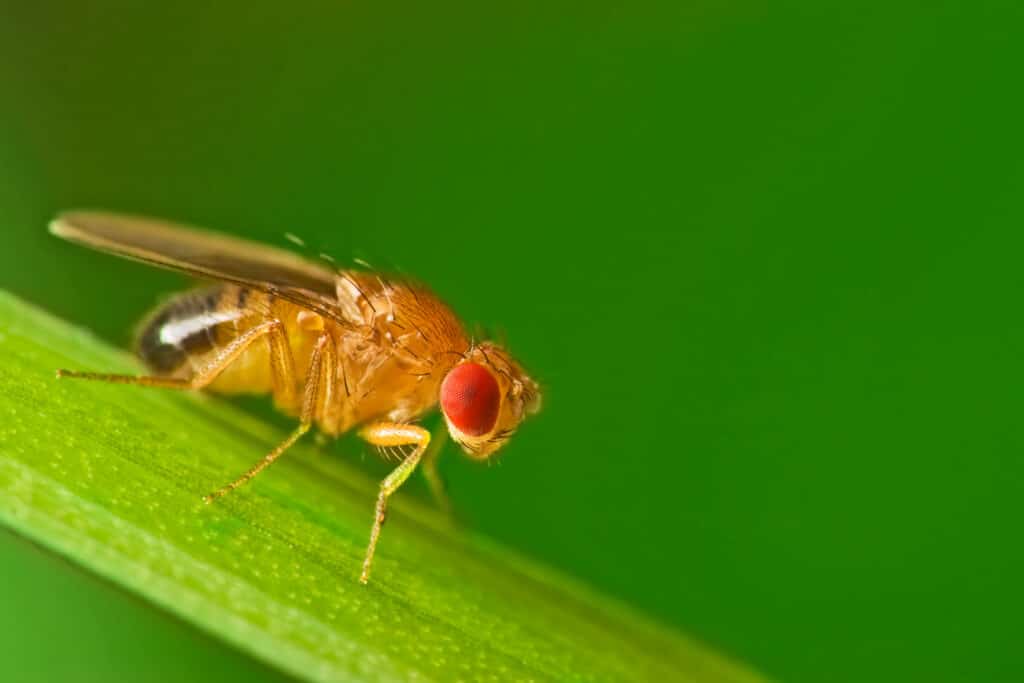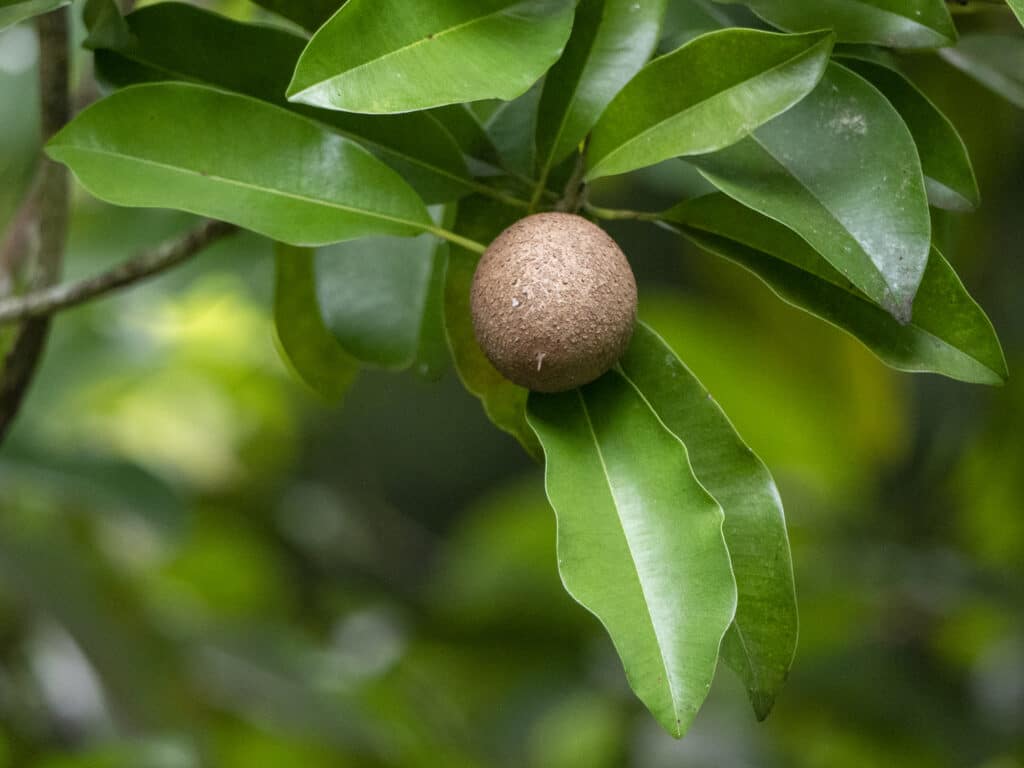Ever heard of Manilkara zapota? Maybe you know it as Sapodilla, Chikoo, or Naseberry. Whatever name you call it, one thing’s for sure—it’s a delicious, easy-to-grow fruit tree that thrives in Hawaii’s tropical climate.
This evergreen tree is a favorite in Hawaiian gardens, not just for its sweet, caramel-flavored fruit but also for its lush, green foliage that provides shade year-round. It’s drought-tolerant, low-maintenance, and loves the Hawaiian sun, making it perfect for home gardens, orchards, and even landscaping.
Sapodilla Details
What Does It Look Like
The Manilkara zapota tree has dark green, glossy, and oval-shaped leaves that grow in clusters at the tips of branches.
Small, pale yellow or cream-colored flowers bloom throughout the year, especially during the wet season, making Manilkara zapota a continuous grower in Hawaii’s tropical climate.
The fruit of Manilkara zapota is round or oval, with rough brown skin and a soft, grainy-textured flesh that becomes sweeter as it ripens.
When Does It Fruit
The Manilkara zapota tree in Hawaii can produce fruit year-round due to the consistent tropical climate.
The heaviest fruiting periods usually occur a few months after the wet season, when the tree has absorbed plenty of moisture for strong growth.
It takes about six to nine months for Manilkara zapota fruit to ripen after flowering, depending on environmental conditions and tree health.
Young Manilkara zapota trees may take four to seven years before they start producing fruit, but patience is rewarded with abundant harvests in later years.

Varieties and Cultivars
Sapodilla comes in several varieties, each with its own unique flavor, texture, and growth characteristics. Choosing the right variety can make a big difference in fruit quality and tree maintenance. Some of the most popular varieties in Hawaii include:
- Makok – This variety produces small, oval-shaped fruit that is extremely sweet. It is highly productive and a great choice for home gardens.
- Alano – Known for its smooth-textured flesh and rich, caramel-like flavor. It is one of the most popular choices for its excellent taste and consistent fruiting.
- Hasya – A large fruit variety with a creamy texture and deep brown flesh. It is favored for its high-quality fruit and attractive appearance.
- Tikal – Produces medium-sized fruit with a balanced sweetness and firm flesh. It grows well in Hawaii’s warm and humid conditions.
- Silas Woods – A dwarf variety that is perfect for small gardens or container growing. Despite its compact size, it still produces delicious fruit.
With so many great options, there is a Sapodilla variety suited for every garden and personal taste. Selecting the right one ensures a steady supply of delicious fruit for years to come.
Best Time to Plant
Year-Round Planting Feasibility
Hawaii’s consistently warm temperatures allow for planting at any time of the year. Soil warmth and steady humidity help young trees develop strong root systems.
The wet season provides natural rainfall, which reduces the need for frequent watering. If planting during the dry season, regular irrigation and mulching are necessary to retain moisture.
No matter when you plant, well-drained soil and proper care will ensure healthy growth.
Ideal Planting Seasons in Hawaii
The wet season (November to April) is the best time to plant Sapodilla trees. Natural rainfall during these months helps young trees establish their root systems more easily.
Planting before the dry season (May to October) gives the tree time to strengthen before facing drier conditions.
If planting in the dry season, extra watering is required to keep the soil moist. Choosing the right season can help the tree grow faster and produce fruit sooner.
Growing Conditions
Ideal Soil Types and pH Levels
Sapodilla grows best in well-drained, sandy, or loamy soil with good aeration.
Heavy clay soil should be avoided unless improved with organic matter to enhance drainage.
The ideal soil pH range is between 6.0 and 7.5, which is slightly acidic to neutral.
Adding compost or mulch helps maintain soil moisture and improves overall soil health.
Proper soil preparation before planting leads to better root development and stronger trees.
Light Requirements
Full sunlight is essential for Sapodilla to grow and produce fruit efficiently.
The tree requires at least six to eight hours of direct sunlight daily for healthy development.
Shaded areas can slow growth and reduce fruit production significantly.
When planting near buildings or other trees, ensure they do not block sunlight.
A sunny location ensures maximum fruit yield and a well-shaped tree.
Temperature and Humidity Preferences
Hawaii’s warm and humid climate is perfect for Sapodilla trees.
They thrive in temperatures between 70°F and 90°F and do not tolerate frost.
High humidity helps maintain healthy leaf growth and supports fruit production.
Dry, strong winds may cause leaf drop, so planting in a protected area can be beneficial.
Consistent tropical weather allows the tree to grow and produce fruit year-round.
Drought Tolerance
Once fully established, Sapodilla is highly drought-tolerant and can survive extended dry periods.
Young trees, however, need regular watering during the first two to three years to establish strong roots.
Applying a layer of mulch around the base helps retain soil moisture and reduces the need for frequent watering.
During extreme dry spells, occasional deep watering supports fruit production.
A well-maintained tree will continue to thrive even in Hawaii’s driest months.
Planting Instructions
Proper planting ensures that a Sapodilla tree grows strong and produces fruit for many years.
Choosing the right location with full sunlight and well-drained soil is important for its success.
Digging a deep and wide hole helps the roots establish quickly and grow properly.
Step-By-Step Guide
Planting a Sapodilla tree the right way will set it up for long-term success.
Follow these simple steps to ensure strong growth and healthy fruit production:
- Choose A Planting Spot – Select a location with full sun and good air circulation.
- Dig A Hole – Make it twice as wide and just as deep as the root ball.
- Place The Tree In The Hole – Backfill with loose, well-draining soil.
- Water Deeply – Hydrate the roots immediately after planting to help them settle.
- Apply A Layer Of Mulch – Spread mulch around the base, but keep it away from the trunk.
Taking the time to plant correctly helps the tree establish itself faster and start producing fruit sooner.
Tips For Successful Establishment
A little extra care in the first few years makes a big difference in the tree’s health.
Here are some useful tips to help your Sapodilla tree grow strong and thrive in Hawaii’s climate:
- Plant At The Start Of The Wet Season – Reduces watering needs and promotes strong root development.
- Water Young Trees Regularly – Keep the soil moist, especially during the first two years.
- Use Well-Draining Soil – Prevents root rot and fungal diseases.
- Avoid Planting Too Close To Structures – Ensure the tree gets enough sunlight and space to grow.
- Protect Young Trees From Strong Winds – Plant near a windbreak or use support stakes if needed.
With proper care and attention, your Sapodilla tree will grow into a beautiful, fruit-producing tree for years to come.
Care and Maintenance
Watering Needs
Watering is especially important during the early years when the tree is still developing its root system.
Young trees need deep watering two to three times per week to establish strong roots.
Mature trees can survive on rainwater alone but benefit from occasional deep watering during long dry periods.
The best method is to soak the soil deeply rather than watering frequently in small amounts.
Applying mulch around the base helps retain moisture and prevents the soil from drying out too quickly.
Overwatering should be avoided, as standing water around the roots can lead to root rot.
Fertilization Recommendations
Fertilizing your Sapodilla tree provides essential nutrients for healthy growth and fruit production.
Young trees should be fertilized every two to three months using a balanced fertilizer, such as 10-10-10, to encourage strong development.
Mature trees benefit from fertilization three times per year with a fruit tree fertilizer containing nitrogen, phosphorus, and potassium.
Organic options like compost, manure, or seaweed-based fertilizers improve soil health and long-term tree growth.
Micronutrients such as iron, zinc, and magnesium may be needed if the leaves turn yellow or show signs of nutrient deficiency.
Excess nitrogen should be avoided, as it can cause excessive leaf growth and reduce fruit production.
Pruning Guidelines
Pruning helps maintain the tree’s shape, improve airflow, and encourage new growth.
In the first year, weak branches should be trimmed to encourage a strong, central structure.
Once a year, dead, damaged, or crossing branches should be removed to promote healthy growth.
Keeping the tree at a manageable height makes fruit picking easier and prevents branches from becoming too heavy.
Thinning out dense areas allows more sunlight to reach the inner branches, reducing the risk of pests and diseases.
Light pruning after harvesting helps stimulate new growth and improves future fruit yields.
Regular care keeps the tree strong, minimizes disease risks, and enhances fruit production.

Common Problems and Solutions
Common Pests
Several pests can target Manilkara zapota trees, especially when the fruit starts to ripen.
These pests can weaken the tree, reduce fruit quality, and even cause damage to the leaves and branches.
- Fruit Flies – Lay eggs inside the fruit, causing it to rot from the inside.
- Scales and Mealybugs – Feed on the sap, weakening the tree and leading to leaf drop.
- Aphids – Cause curled leaves and reduced growth by sucking nutrients from the plant.
- Spider Mites – Thrive in dry conditions and leave tiny webs on leaves while damaging foliage.
- Thrips – Small insects that attack young leaves and flowers, causing distortion and discoloration.
Regular inspections and natural pest control methods help keep infestations under control.
By monitoring your Manilkara zapota tree and taking quick action, you can prevent serious pest damage.
Common Diseases
Fungal infections are the most common diseases affecting Manilkara zapota trees in humid conditions.
These diseases often develop due to excessive moisture, poor airflow, or improper soil drainage.
- Leaf Spot Disease – Causes dark brown or black spots on leaves, often due to excess moisture.
- Powdery Mildew – Covers leaves with a white, powdery coating, usually in shaded or poorly ventilated areas.
- Root Rot – Develops in poorly drained soil or when the tree is overwatered for long periods.
- Anthracnose – Leads to fruit rot and leaf damage, especially during prolonged wet conditions.
- Sooty Mold – Grows on leaves covered in honeydew from sap-sucking insects like aphids and scales.
Proper pruning, good air circulation, and well-drained soil help prevent most fungal infections.
By maintaining a clean and healthy growing environment, you can keep your Manilkara zapota tree disease-free and thriving.
Preventative Measures and Treatments
Keeping the Manilkara zapota tree healthy is the best way to prevent pests and diseases.
Taking preventive steps early on can save you time and effort in treating major problems later.
Planting Manilkara zapota in a sunny, well-ventilated area helps reduce fungal infections by keeping the leaves dry.
Applying mulch around the base of the tree improves soil health and prevents moisture loss.
Using organic pest control methods, such as neem oil or introducing beneficial insects, can help manage pests.
Pruning regularly removes weak or diseased branches and allows better airflow through the canopy.
If pests or diseases become a major issue, targeted treatments like insecticidal soap or copper fungicide may be needed.
Uses and Landscaping Tips
Landscaping Benefits
Manilkara zapota is a fantastic tree for tropical landscapes because it offers both aesthetic and practical benefits.
Its evergreen foliage ensures that it looks lush and green throughout the year.
The tree’s ability to withstand strong winds makes it suitable for planting in open spaces.
Its deep roots make it a great choice for erosion control on slopes and coastal areas.
The combination of beauty, durability, and fruit production makes it a versatile tree for any setting.
Companion Planting Ideas
Planting Manilkara zapota alongside other tropical plants can improve growth and fruit production.
Banana trees, papayas, and mangoes are excellent companions because they thrive in similar soil and climate conditions.
Leguminous plants like pigeon peas help enrich the soil by adding nitrogen, which benefits the tree’s health.
Marigolds and basil are great additions to help repel pests naturally and protect the tree.
By choosing the right companion plants, you can create a balanced and productive tropical garden.
Practical Uses of Manilkara Zapota
Beyond its landscaping benefits, Manilkara zapota serves many practical purposes.
The fruit is rich in fiber, vitamins, and antioxidants, making it a nutritious snack.
The tree’s hard, durable wood is used for construction, furniture, and even boat-building.
Historically, its sap was once harvested to produce natural chewing gum.
With so many uses, Manilkara zapota is a valuable tree that offers both beauty and function.
Propagation Methods
Growing From Seeds
Propagating Manilkara zapota from seeds is the easiest method, but it takes the longest to bear fruit.
Seeds should be collected from fully ripe fruit and cleaned before planting.
They need to be planted in well-draining soil and kept consistently moist to germinate.
Seedlings usually take five to eight years before they start producing fruit.
Although slow, this method is great for those who want to grow a tree from scratch with minimal effort.
Grafting Techniques
Grafting is the most reliable method for growing Manilkara zapota with high-quality fruit.
It involves attaching a branch from a mature, fruiting tree onto a young seedling.
This method ensures that the new tree will inherit the desirable fruit characteristics of the parent tree.
Grafted trees begin producing fruit much faster, usually within three to four years.
Many commercial growers and home gardeners prefer this method for consistent fruit production.
Air-Layering Method
Air-layering is another effective way to propagate Manilkara zapota without using seeds.
A small section of a branch is wounded and wrapped in moist soil or moss to encourage root growth.
Once roots form, the branch is cut and planted as a new tree.
This method allows for faster fruiting since the new tree is already mature.
Air-layering is an excellent choice for those looking to clone an existing tree with strong growth and sweet fruit.
With the right propagation method, you can successfully grow a Manilkara zapota tree that thrives in Hawaii’s tropical environment.
Environmental Impact and Benefits
Ecological Benefits
Manilkara zapota contributes to a healthier environment in several ways.
Its dense foliage provides shelter for birds, pollinators, and beneficial insects.
The tree absorbs carbon dioxide and improves air quality, making it valuable for urban and suburban areas.
Its deep root system helps stabilize the soil, reducing the risk of erosion in coastal and sloped areas.
By producing fruit, it supports local biodiversity, feeding birds, bees, and other wildlife.
With minimal maintenance, Manilkara zapota adds both beauty and environmental value to Hawaiian gardens.
Potential Drawbacks
Despite its many benefits, there are a few challenges to keep in mind before planting Manilkara zapota.
The tree is slow-growing, which means it takes several years before it reaches full size and begins producing fruit.
It can attract pests like fruit flies and mealybugs, which may require regular monitoring and control.
Fallen fruit can create a mess if the tree is planted too close to sidewalks or driveways.
Conclusion
Manilkara zapota is a valuable tree for Hawaiian gardens, offering delicious fruit, shade, and environmental benefits.
Its ability to thrive in warm, tropical conditions makes it an excellent choice for home orchards and landscaping.
With proper planting, care, and pest management, it can provide years of steady fruit production.
While it has a slow growth rate, its durability and low-maintenance nature make it worth the wait.
Whether grown for its sweet fruit, shade, or ornamental appeal, Manilkara zapota is a perfect addition to any tropical landscape.


